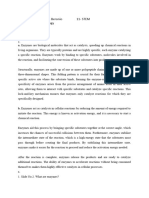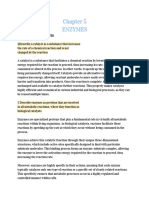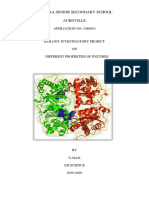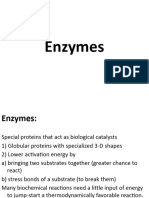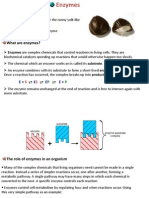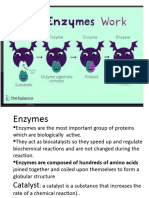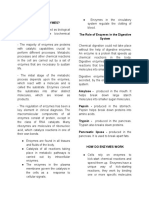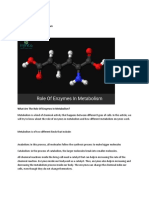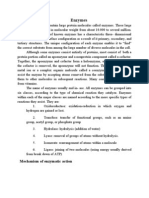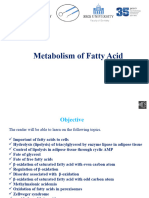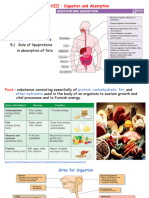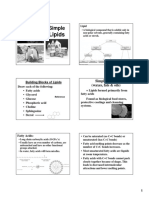0 ratings0% found this document useful (0 votes)
Paper 1 Test
Paper 1 Test
Uploaded by
muhammadzavi98786Copyright:
© All Rights Reserved
Available Formats
Download as TXT, PDF, TXT or read online from Scribd
Download as txt, pdf, or txt
Paper 1 Test
Paper 1 Test
Uploaded by
muhammadzavi987860 ratings0% found this document useful (0 votes)
Original Title
Paper1Test
Copyright
© © All Rights Reserved
Available Formats
TXT, PDF, TXT or read online from Scribd
Share this document
Did you find this document useful?
Is this content inappropriate?
Copyright:
© All Rights Reserved
Available Formats
Download as TXT, PDF, TXT or read online from Scribd
Download as txt, pdf, or txt
0 ratings0% found this document useful (0 votes)
Paper 1 Test
Paper 1 Test
Uploaded by
muhammadzavi98786Copyright:
© All Rights Reserved
Available Formats
Download as TXT, PDF, TXT or read online from Scribd
Download as txt, pdf, or txt
You are on page 1/ 2
Title: Understanding Enzymes: Biological Catalysts Essential for Life
Enzymes are specialized proteins that function as catalysts, accelerating chemical
reactions within biological systems. Without enzymes, most biochemical reactions
within cells would occur far too slowly to sustain life. Enzymes lower the
activation energy required for reactions, meaning they make it easier and faster
for reactions to occur at normal body temperatures.
Structure and Function of Enzymes
Enzymes are primarily composed of amino acids linked in unique sequences that fold
into complex three-dimensional shapes. These shapes are vital for enzyme function
because they create active sites—specific regions where substrates, the molecules
undergoing the reaction, bind. The "lock and key" model illustrates this
specificity: only substrates with a complementary shape can fit into the enzyme’s
active site. Some enzymes have a more flexible active site that adjusts to fit the
substrate, a concept known as the "induced fit" model.
Once bound to the substrate, the enzyme facilitates a chemical change, transforming
the substrate into one or more products. After the reaction, the enzyme is released
unchanged, ready to catalyze another reaction. This reusability is one reason
enzymes are so efficient and essential in cells.
Types of Enzymes and Examples
Enzymes are classified into six main categories based on the types of reactions
they catalyze:
Oxidoreductases: Involved in oxidation-reduction reactions. Example: lactate
dehydrogenase, which helps convert lactic acid into pyruvic acid.
Transferases: Transfer functional groups from one molecule to another. Example:
alanine transaminase, which plays a role in amino acid metabolism.
Hydrolases: Catalyze hydrolysis reactions, where water breaks bonds. Example:
amylase, an enzyme in saliva that helps digest starch.
Lyases: Break chemical bonds without water, often forming double bonds. Example:
decarboxylase, which removes carboxyl groups.
Isomerases: Facilitate the rearrangement of atoms within a molecule. Example:
phosphoglucose isomerase, an enzyme in glycolysis.
Ligases: Join two molecules, typically with energy from ATP. Example: DNA ligase,
which seals breaks in DNA.
Enzyme Activity and Factors Affecting It
Several factors influence enzyme activity, including temperature, pH, substrate
concentration, and the presence of inhibitors or activators. Enzymes function
optimally within specific temperature and pH ranges. For instance, human enzymes
generally perform best at body temperature (37°C) and near-neutral pH levels.
Extremes in temperature or pH can denature enzymes, altering their structure and
deactivating them.
Enzymes are also affected by substrate concentration. At low concentrations,
increasing the substrate boosts the reaction rate until the enzyme becomes
saturated. Beyond this point, adding more substrate does not increase the reaction
speed. Additionally, enzymes can be regulated by molecules that inhibit or enhance
their function, allowing the body to maintain precise control over metabolic
pathways.
Enzymes in Medicine and Industry
Enzymes have applications far beyond biological processes; they are essential in
medicine, food production, and environmental management. In medicine, enzymes such
as streptokinase help dissolve blood clots, while enzyme replacement therapies aid
those with metabolic disorders. In industry, enzymes improve the efficiency of
processes like brewing, baking, and biofuel production. Enzymes are also used in
environmental applications, such as breaking down pollutants and waste products in
water treatment.
Conclusion
In summary, enzymes are indispensable biological catalysts that sustain life by
facilitating biochemical reactions with remarkable speed and specificity. Their
diverse roles in nature and applications in science and industry underscore their
significance in both living systems and modern technology.
You might also like
- Biochemistry For Medical Laboratory Science Course Outline 2018100% (3)Biochemistry For Medical Laboratory Science Course Outline 20184 pages
- Enzymes: Biology Lecture Prepared By: Waleed Zahoor Team Roshni Step-Up PakistanNo ratings yetEnzymes: Biology Lecture Prepared By: Waleed Zahoor Team Roshni Step-Up Pakistan11 pages
- General Biology 1 (Factors Affecting Enzymes)100% (1)General Biology 1 (Factors Affecting Enzymes)4 pages
- Enzymes - Catalysts of Life (Reading Material)No ratings yetEnzymes - Catalysts of Life (Reading Material)1 page
- The Nature, Properties and Classifiication Ofi Enzymes and CofiactorsNo ratings yetThe Nature, Properties and Classifiication Ofi Enzymes and Cofiactors24 pages
- Chapter - 4 Enzymes: Information Sheet-5No ratings yetChapter - 4 Enzymes: Information Sheet-55 pages
- Subject Name: 1st Year/Biology 11: I) Tick The Correct Option: (All Questions / Options - 20 / 0) 0 MarksNo ratings yetSubject Name: 1st Year/Biology 11: I) Tick The Correct Option: (All Questions / Options - 20 / 0) 0 Marks4 pages
- Enzymes (2.4.1) DP IB Biology SL Revision Notes 2016 Save My ExamsNo ratings yetEnzymes (2.4.1) DP IB Biology SL Revision Notes 2016 Save My Exams1 page
- Stem Biology Grade 12 SRB - Term 1 (Thema Biotechnology) - 01262022 - 094504No ratings yetStem Biology Grade 12 SRB - Term 1 (Thema Biotechnology) - 01262022 - 09450460 pages
- Intro To Biohacking: or "How I Learned To Stop Worrying and Love The Zombie Apocalypse"No ratings yetIntro To Biohacking: or "How I Learned To Stop Worrying and Love The Zombie Apocalypse"31 pages
- Department of Education: Republic of The Philippines Region Xii Division of Sultan KudaratNo ratings yetDepartment of Education: Republic of The Philippines Region Xii Division of Sultan Kudarat4 pages
- Biology Investigatory Project: Podar International School0% (1)Biology Investigatory Project: Podar International School10 pages
- Color Tests Albumin Casein Gelatin Methioni Ne Cystein AlanineNo ratings yetColor Tests Albumin Casein Gelatin Methioni Ne Cystein Alanine4 pages
- Chemistry Class 12th Project - DNA and RNA 2 (Complete Content PDF100% (1)Chemistry Class 12th Project - DNA and RNA 2 (Complete Content PDF34 pages






